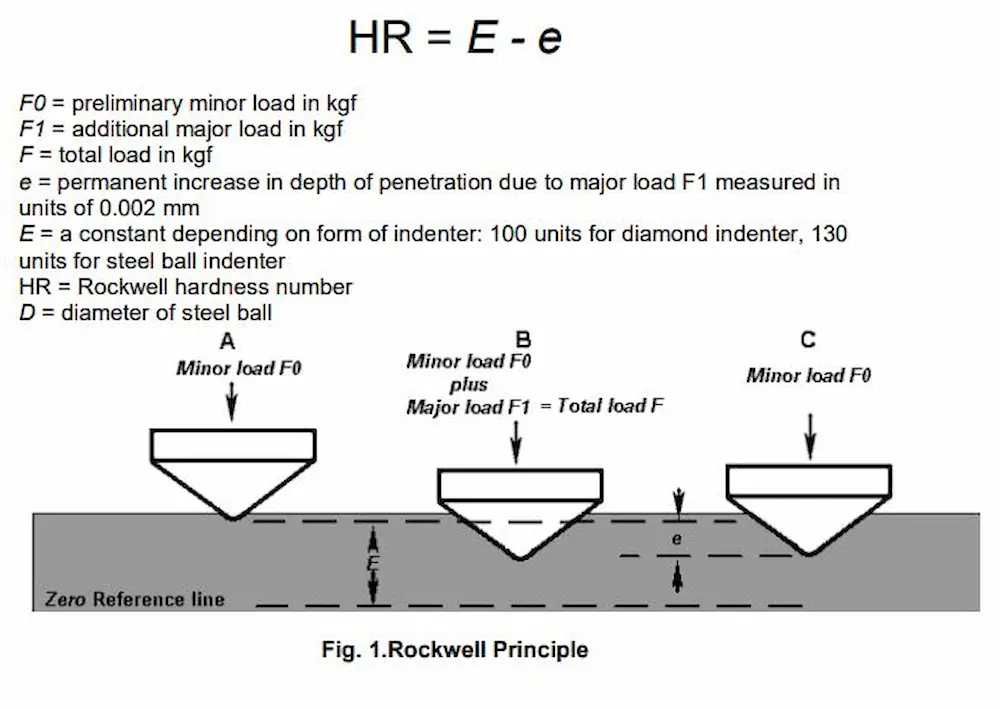Rockwell Hardness Test
The Rockwell hardness test method consists of indenting the test material with a diamond cone or hardened steel ball indenter. The indenter is forced into the test material under a preliminary minor load F0 (Fig. 1A) usually 10 kgf. When equilibrium has been reached, an indicating device, which follows the movements of the indenter and so responds to changes in depth of penetration of the indenter is set to a datum position. While the preliminary minor load is still applied an additional major load is applied with resulting increase in penetration (Fig. 1B). When equilibrium has again been reach, the additional major load is removed but the preliminary minor load is still maintained. Removal of the additional major load allows a partial recovery, so reducing the depth of penetration (Fig. 1C). The permanent increase in depth of penetration, resulting from the application and removal of the additional major load is used to calculate the Rockwell hardness number.

Rockwell Hardness Scales
| Scale | Indenter | Minor Load F0 kgf | Major Load F1 kgf | Total Load F kgf | Value of E |
|---|---|---|---|---|---|
| A | Diamond cone | 10 | 50 | 60 | 100 |
| B | 1/16" steel ball | 10 | 90 | 100 | 130 |
| C | Diamond cone | 10 | 140 | 150 | 100 |
| D | Diamond cone | 10 | 90 | 100 | 100 |
| E | 1/8" steel ball | 10 | 90 | 100 | 130 |
| F | 1/16" steel ball | 10 | 50 | 60 | 130 |
| G | 1/16" steel ball | 10 | 140 | 150 | 130 |
| H | 1/8" steel ball | 10 | 50 | 60 | 130 |
| K | 1/8" steel ball | 10 | 140 | 150 | 130 |
| L | 1/4" steel ball | 10 | 50 | 60 | 130 |
| M | 1/4" steel ball | 10 | 90 | 100 | 130 |
| P | 1/4" steel ball | 10 | 140 | 150 | 130 |
| R | 1/2" steel ball | 10 | 50 | 60 | 130 |
| S | 1/2" steel ball | 10 | 90 | 100 | 130 |
| V | 1/2" steel ball | 10 | 140 | 150 | 130 |
Typical Application of Rockwell Hardness Scales
- HRA . . . . Cemented carbides, thin steel and shallow case hardened steel
- HRB . . . . Copper alloys, soft steels, aluminium alloys, malleable irons, etc.s
- HRC . . . . Steel, hard cast irons, case hardened steel and other materials harder than 100 HRB
- HRD . . . . Thin steel and medium case hardened steel and pearlitic malleable iron
- HRE . . . . Cast iron, aluminium and magnesium alloys, bearing metals
- HRF . . . . Annealed copper alloys, thin soft sheet metals
- HRG . . . . Phosphor bronze, beryllium copper, malleable irons
- HRH . . . . Aluminium, zinc, lead
- HRK . . . . }
- HRL . . . . }
- HRM . . . .}. . . . Soft bearing metals, plastics and other very soft materials
- HRP . . . . }
- HRR . . . . }
- HRS . . . . }
- HRV . . . . }
Advantages of the Rockwell hardness method include the direct Rockwell hardness number readout and rapid testing time. Disadvantages include many arbitrary nonrelated scales and possible effects from the specimen support anvil (try putting a cigarette paper under a test block and take note of the effect on the hardness reading! Vickers and Brinell methods don't suffer from this effect).